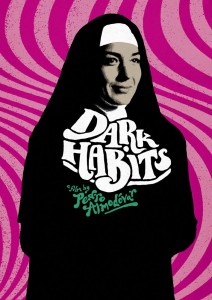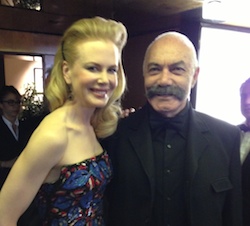 It was only a matter of time before Almodovar, a product of rigid Catholic education, would turn his critical attention to the Spanish church, and indeed, his third feature, “Dark Habits” (“Entre Tinieblas”), is a ferocious attack on institutionalized religion. While expected to be an outrageous satire of convent life, “Dark Habits” is essentially a conventional melodrama, and one of the most linear in the director’s output. Thematically, like other Almodovar films, “Dark Habits” is an anatomy of obsessive romanticism, which then expectedly turns into doomed love and violent death.
It was only a matter of time before Almodovar, a product of rigid Catholic education, would turn his critical attention to the Spanish church, and indeed, his third feature, “Dark Habits” (“Entre Tinieblas”), is a ferocious attack on institutionalized religion. While expected to be an outrageous satire of convent life, “Dark Habits” is essentially a conventional melodrama, and one of the most linear in the director’s output. Thematically, like other Almodovar films, “Dark Habits” is an anatomy of obsessive romanticism, which then expectedly turns into doomed love and violent death.
The film is set against a climate of denial and repression, two of Almodovar’s most consistent issues. The film’s Spanish title, “Entre Tinieblas,” refers to a Catholic ritual. Tenebrae are the days before Good Friday, when candles are extinguished in church, and as such, they imply the socio-religious processes of sacrifice and redemption. The story centers on Yolanda (Cristina Sánchez Pascal), a cabaret singer who witness the imminent death of her lover after a drug overdose. Like other male figures in Almodovar’s work, the boyfriend comes across as gruff and unsympathetic.

Gay Directors: Almodovar, Haynes, Van Sant, John Waters: By Emanuel Levy (Columbia University Press).
Desperate to escape the police, Yolanda recalls a visit from the local convent’s nuns who claimed to be her admirers. The function of the order, named the Humiliated Redeemers, is to serve as a shelter for “fallen women,” just like Yolanda. Upon arrival at the convent, Yolanda is greeted by Mother Superior (Julieta Serrano), only to realize that she is the only resident. All the nuns– Sister Manure (Marisa Paredes), Sister Damned (Carmen Maura), Sister Snake (Lina Canalejas), and Sister Sewers Rat (Chus Lampreave)—grant Yolanda a warm welcome. Predictably, they turn out to be a bunch of eccentrics: Sister Damned likes pet tigers, Sister Manure bakes LSD-cakes, Sister Sewer Rat writes soft-core romans à clefs.
Mother Superior becomes obsessed with Yolanda, and the two embark on a romantic bliss induced by drug abuse. But later on, Yolanda decides to change her ways, and works hard in putting her life back together. If withdrawal for Yolanda is a painful catharsis, but cathartic nonetheless, for Mother Superior, it represents a public confirmation of sinful life. Lusting for sex and drugs has made Mother Superior worse than the women she is supposed to help. Meanwhile, the convent is falling apart and is threatened with closure. Mother Superior thinks that drug trafficking would help her to maintain the convent’s independence. Soon, however, most of the nuns, including Yolanda, leave.
In theory, the combination of Almodóvar and convent suggests a sacrilegious kitsch or high camp, in the vein of American playwright Christopher Durang’s witty spoof, “Sister Mary Ignatius Explains It All for You.” Yet “Dark Habits” is a rather quiet and tender melodrama. Though hedonism prevails in the Humble Redeemers community, Almodovar focuses on the characters and the dynamics of threir relationships.
Mother Superior’s love for Yolanda pay homage to La Religieuse, Denis Diderot’s French novel, which was completed circa 1780 but was not published until 1796, after the author’s death. (In Francis Birrell’s English translation, it is called “The Nun,” or “Memoirs of a Nun”). Alomodovar relished the fact that the novel originated not as a public literary work, but as an elaborate practical joke aimed at luring back to Paris the Marquis de Croismare, Diderot’s companion. The novel consists of a series of letters purporting to be from a nun named Suzanne, who implores the Marquis to help her renounce her vows, describing an intolerable life in a convent to which she has been sent against her will. Diderot later revised the letters into a novel, drawing attention both to the cruelty of forcing young women into convents in order to get them out of the way, and the corruption rampant among the clergy. When Diderot publicly admitted his role in the ruse, the Marquis is said to have laughed–he had behaved with genuine compassion in his willingness to help the imaginary Suzanne.
Almodóvar is not as interested in delivering anti-clerical messages as the late great Luis Buñuel, who was also inspired by Diderot in such harsh anti-religious films as “Viridiana.” (“La Religieuse” has been adapted several times for the big-screen, most notably in 1966 as “The Nun,” by French New Wave leader Jacques Rivette, starring Anna Karina and Liselotte Pulver, and in 2013 as “The Nun,” starring Isabelle Huppert).
“Dark Habits” has no major male characters, reaffirming Almodovar’s commitment to women-driven cinema. But there is no negative portrayal of the few males that exist. For example, the worst things that the Chaplain (Manuel Zarzo), who significantly has no name, does in the story is to smoke while extolling Cecil Beaton’s fabulous costumes in George Cukor’s 1964 Oscar-winning musical, “My Fair Lady,” or give the church’s statues a polish, while assisted by his secret lover, Sister Viper.
Like most of Almodovar’s screen persona, the characters in “Dark Habits” are driven by unusual, subversive instincts. For Almodóvar, the greatest sin in life is not deviance or crime but the denial of desires and feelings. “Dark Habits” tries to balance its characters’ subversive impulses with their need for spiritual redemption. It is “in the imperfect creatures that God finds all His greatness,” Mother Superior says, ironically serving as the director’s spokesperson. Almodóvar’s critique is not so much of religion, but of rigid authoritarian institutions (including the church), which suppress individualism and obliterate desire.
Denying that “Dark Habits” was anti-clerical, Almodovar said that he just wanted to point out the absolute autonomy of the nuns, whose authority is not restricted by any norms. “I didn’t want to shock, and it’s not scandal I’m looking for.” Moreover, for him, “Dark Habits” was a “Christmas film, because it follows exactly the doctrine that in order to save sinners, you have to become one of them.” Thus, the director’s fans expecting a serio-comic critique of the church and its practitioners were disappointed with the end result shown on screen.
Stylistically, “Dark Habits” is the first film in which Almodovar deployed more elegant stylistic devices. Note the long tracking shots in which the camera follows Mother Superior down the chapel’s aisles, placing her in perspective. Or the high angle shots, which call attention to the women’s claustrophobia and their minor stature against the foreboding structure.
 The color red, a visual motif of Almodovar, is prominent throughout the picture, from the first frames, in which Yolanda’s red-nailed fingers are observed, using scissors with relish in cutting her boyfriend from the photos that she is signing for the admiring nuns. And red continues to be prominent: Yolanda, Merchese, and the young drug dealer who visit the Mother Superior are in red, in sharp contrast to the convent’s drab color. In one scene, there’s a sharp cut from Yolanda’s red-nailed fingers, holding tight the nuns’ visiting card, to a scarlet lipstick trace on a photo (which is black and white) to mega close-up of the Marquesa (trained as a make-up artist) applying red lipstick. There’s hardly an Almodovar film which doesn’t contain a scene showing women, no matter how oppressed or depressed, using make-up, specifically hot red lipstick, in an effort to make themselves look and feel better.
The color red, a visual motif of Almodovar, is prominent throughout the picture, from the first frames, in which Yolanda’s red-nailed fingers are observed, using scissors with relish in cutting her boyfriend from the photos that she is signing for the admiring nuns. And red continues to be prominent: Yolanda, Merchese, and the young drug dealer who visit the Mother Superior are in red, in sharp contrast to the convent’s drab color. In one scene, there’s a sharp cut from Yolanda’s red-nailed fingers, holding tight the nuns’ visiting card, to a scarlet lipstick trace on a photo (which is black and white) to mega close-up of the Marquesa (trained as a make-up artist) applying red lipstick. There’s hardly an Almodovar film which doesn’t contain a scene showing women, no matter how oppressed or depressed, using make-up, specifically hot red lipstick, in an effort to make themselves look and feel better.
The film’s novel points reside in the exploration of taboo issues, such as lesbianism, fetishism, and voyeurism, all in a female-dominated context. “My only sin is to love you too much,” says the Mother Superior upon meeting Yolanda. The Mother Superior displays in her room photos of such “famous sinners” as the French Brigitte Bardot and the American Marilyn Monroe, two major sex icons of the 1950s. When the Mother Superior is visited by the young Merche (Cecilia Roth), a former inmate on the run from the police, the nun stoops to replace Merche’s shoes as she is taken to prison.
The movie ends with Yolanda deserting the Mother Superior. As Sor Estiercol cradles the Mother Superior in her arms, the camera pulls out of the window, leaving the two women enclosed in this frame within frame. This scene may pay an ironic tribute to Douglas Sirk’s device of framing his heroines behind closed windows or doors to suggest their helplessness and imprisonment in their own homes.
Reflecting his own social class, most of Almodovar’s features have focused sympathetically on the plight of contemporary working class women. However, while Almodovar puts women front and center, he doesn’t follow any doctrinaire feminist ideology or any other rigid political platform. By challenging established sex and gender roles, Almodovar has contested Spain’s long-prevailing stereotypes of sexual politics–machismo men on the one hand and long-suffering women on the other. In the process, he has helped to abolish, within and without cinema. Spain’s reactionary past, defined by rigid patriarchy and sexual segregation. Almodovar has been seeking truth in travesty through uncompromising explorations of universal issues like sex, love, and happiness.
He has placed strong females center-stage and weak male characters in the periphery, or altogether offstage. Almodovar doesn’t identify with women, as has been suggested by some critics, but he claims to feel strong affinity with them: “I write better for women than for men, who are dramatically boring to me. I am better able to incorporate my talent for wackiness in female than male characters.” As a result, there are far less males than females in his work. Early on, Almodovar has expressed his motto: “I’m aware that my liking of the private life of women may still be a reflection of machismo. But I hope not. Because I’m really interested in women and their world, not just when they go to gossip in the bathroom, but at all times. I believe I’m one of the least machista men in the world and one of the most authentically feminist.”
Almodovar’s films have shown the ordinary elements in the extraordinary lives of women, and vice versa, the extraordinary aspects in women’s ordinary existence. The excess and eccentricity are accepted by him as natural and normal states or being, not as phenomena that call for explanation. Like other gay directors, he has questioned what society considers normal and devious, normative and deviant. He has portrayed the sensational aspects of everyday life and has broken filmic taboos and social codes with remarkable ease and naturalness. The “real” and “external” worlds of his characters are integrated into unusually complicated texts.










